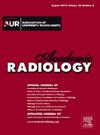Radiomics Model Based on Contrast-enhanced CT Intratumoral and Peritumoral Features for Predicting Lymphovascular Invasion in Hypopharyngeal Squamous Cell Carcinoma
IF 3.8
2区 医学
Q1 RADIOLOGY, NUCLEAR MEDICINE & MEDICAL IMAGING
引用次数: 0
Abstract
Rationale and Objectives
Patients with Hypopharyngeal Squamous Cell Carcinoma (HSCC) exhibiting lymphovascular invasion (LVI) frequently demonstrate a poor prognosis. We aim to determine whether contrast-enhanced computed tomography (CECT)-derived intratumoral and peritumoral radiomic features could predict the LVI status of HSCC patients.
Materials and Methods
166 patients with pathologically confirmed HSCC were included in this study, 47 of whom were LVI positive. Preoperative CECT data were randomly divided into a training dataset and a validation dataset in an 8:2 ratio. A total of 1648 radiomics features were extracted from the total tumor volume (GTV) and the surrounding 1- to 5-mm-wide tumor margins (labeled as Peri1V-5V). A deep learning model based on the GTV was also constructed. Radiomics nomograms were established by integrating deep learning model features and clinical features. Receiver operating characteristic curve (ROC), calibration curve, and decision curve analysis (DCA) were utilized to evaluate and compare the predictive performance of all models.
Results
Peri1V-Radscore showed the best prediction efficiency in the validation dataset among all peritumoral models. Among the clinical variables, the upper tumor boundaries and clinical N stage were independent predictors. Compared with the clinical predictor model, Peri1V-Radscore, deep learn model and Nomogram model can improve prediction efficiency in LVI status. Their respective AUC values were 0.94, 0.84, and 0.96. The results of DCA showed that a good net benefit could be obtained from the Peri1V-Radscore model.
Conclusion
Intratumoral combined peritumoral radiomics model based on CECT can superior predict LVI status in HSCC patients and may have significant potential for future applications in clinical practice.
基于增强CT瘤内和瘤周特征预测下咽鳞状细胞癌淋巴血管浸润的放射组学模型。
理由和目的:下咽鳞状细胞癌(HSCC)表现为淋巴血管侵犯(LVI)的患者往往表现为预后不良。我们的目的是确定对比增强计算机断层扫描(CECT)衍生的肿瘤内和肿瘤周围放射学特征是否可以预测HSCC患者的LVI状态。材料和方法:本研究纳入166例病理证实的HSCC患者,其中47例LVI阳性。术前CECT数据按8:2的比例随机分为训练数据集和验证数据集。从肿瘤总体积(GTV)和周围1- 5mm宽的肿瘤边缘(标记为Peri1V-5V)中提取了1648个放射组学特征。在此基础上,构建了基于GTV的深度学习模型。将深度学习模型特征与临床特征相结合,建立放射组学图。采用受试者工作特征曲线(ROC)、校准曲线和决策曲线分析(DCA)对各模型的预测性能进行评价和比较。结果:在所有肿瘤周围模型中,Peri1V-Radscore在验证数据集中的预测效率最高。在临床变量中,肿瘤上界和临床N分期是独立的预测因素。与临床预测模型相比,Peri1V-Radscore、深度学习模型和Nomogram模型能提高LVI状态的预测效率。AUC分别为0.94、0.84和0.96。DCA结果表明,Peri1V-Radscore模型可获得较好的净效益。结论:基于CECT的瘤内联合瘤周放射组学模型能较好地预测HSCC患者的LVI状态,在临床应用中具有重要的潜力。
本文章由计算机程序翻译,如有差异,请以英文原文为准。
求助全文
约1分钟内获得全文
求助全文
来源期刊

Academic Radiology
医学-核医学
CiteScore
7.60
自引率
10.40%
发文量
432
审稿时长
18 days
期刊介绍:
Academic Radiology publishes original reports of clinical and laboratory investigations in diagnostic imaging, the diagnostic use of radioactive isotopes, computed tomography, positron emission tomography, magnetic resonance imaging, ultrasound, digital subtraction angiography, image-guided interventions and related techniques. It also includes brief technical reports describing original observations, techniques, and instrumental developments; state-of-the-art reports on clinical issues, new technology and other topics of current medical importance; meta-analyses; scientific studies and opinions on radiologic education; and letters to the Editor.
 求助内容:
求助内容: 应助结果提醒方式:
应助结果提醒方式:


